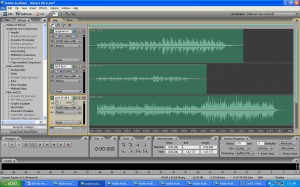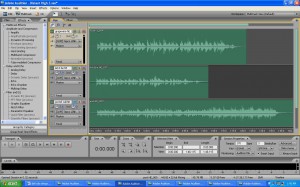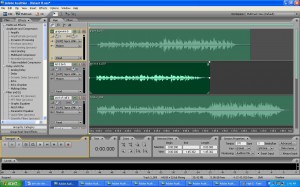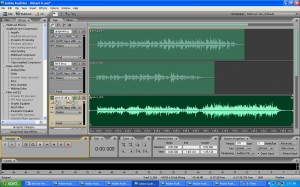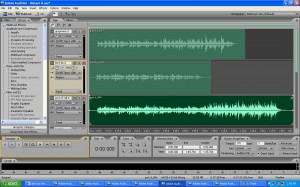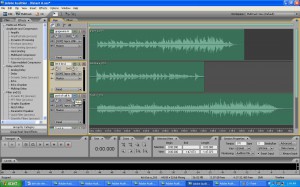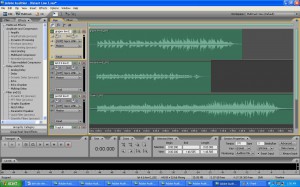Guitar Glitching? A Study of Absences
The Idea
Struck by John Law’s article “Making A Mess With Method,” I became interested in the necessarily “othered” parts of research in general – those factors that are ignored or left out in any given experiment’s report which indeed likely have some sort of significance in any given experiment, its process and its results. Law gives the general examples of “invisible work” as in things that make a research project possible in the first place, “the uninteresting” or things that do not seem to be worth talking about in a report, the “obvious” or common knowledge, things taken for granted, and information that gets “repressed” or “othered” for some unknown reason (8). I began to think about how I might be able to apply this idea to an experiment of my own, and I wanted to involve music in some way. And so, obviously stretching Law’s arguments, I thought about recording a few songs with my guitar in an unorthodox way so that I might uncover what can become “othered,” in a given guitar recording. I mean to say that my goal here was to find out which strings might be “taken for granted,” or are seemingly more inaudible or less important when we listen to a traditional, fully strung guitar recording. Do we tend to gloss over certain strings when we listen to a recording? Are some strings more integral to certain songs than others?
To answer these questions, my idea was thus to play the same three songs seven times each, once with all the strings on the guitar, and then each subsequent recording with a specific string taken off of the guitar (always maintaining five strings on the guitar for each recording of the three songs). I plan to both analyze the process of recording and compare the waveforms themselves. I will also try to be as elaborate as possible in this report on the process itself as to minimize these traditionally “othered” factors in experimental reports. Indeed this is not really guitar glitching per se, for a glitch is more of an unexpected and unprovoked result of using a tool, but I am pretty into alliteration, and so I am sticking with the title. I decided upon three songs – The Beatles “Let It Be” (because everyone knows it), Death Cab For Cutie’s “Grapevine Fires” (because it is essentially the same four chords all the way through), and Beirut’s “Port of Call” (because it varies greatly from the other two songs – it is generally not well known, it is in a 3/4 time signature whereas the other two songs are in 4/4, and it is mildly all over the place in terms of its chord progression).
The Setup
A fourteen year old Mexican Fender Stratocaster electric guitar, strung with Classic Ernie Ball Rock & Roll strings gauge 10-46, set to max volume and tone and set to pick up sound with only the humbucker bridge pickup, tuned to what is referred to as standard guitar tuning (from “fattest” string to “thinnest” string – E A D G B E). A Polytune polyphonic tuning pedal (without which I would have lost my damn mind with all the tuning I had to do). A Fender Premium Chorus guitar amplifier set to 2/5 volume, 4/5 treble, 1/2 mid and 2/5 bass (i.e. the settings I thought sounded pretty good). An EV N/D767a vocal microphone using an XLR to XLR connection (to mic the guitar amp). An eight year old Toshiba Satellite laptop with a pirated version of Adobe Audition 3.0. A Tapco LINK firewire 4X6 audio interface (basically the channel between the microphone and the computer). I kept the input gain on the audio interface set at 1/2 for every recording. Oh and I suppose I myself am part of the setup. I have been playing guitar since 1998, so I reckon I am at least somewhat qualified to act as the musician in this experiment. Recorded in Pointe Claire QC in a basement, November 23rd 2014 (luckily before 8PM when a windstorm knocked out the power in the area).
The Method
First, I recorded each of the three songs with a fully strung guitar with strings that had been “broken in,” but still had some good life in them (I probably played them for about an hour beforehand). Second, I removed the high E string (the thinnest string), re-tuned the remaining five strings and recorded the same three songs again. For each subsequent recording, I had to replace the previously removed string and remove the next string in sequence. So for example, for the third recording I replaced the high E string (sidenote: replacing strings entails stretching the new string a bit and playing it a bit to “break it in” – this prevents the new string from going out of tune easily), tuned the high E string properly, removed the B string, tuned all the remaining strings, and recorded the three songs again. I repeated this process until I had recorded each of the three songs with different missing strings. I also re-tuned the guitar after I had played each individual song (just as a precaution, most of the time it was unnecessary, luckily my guitar stays in tune quite well). I also used a metronome (there’s one built into Adobe Audition and it is very good) to maintain consistency about the beat, rhythm and length of each recording. I played the metronome through headphones so that the microphone would not pick it up, and I set the metronome at 6dB on Audition and set the headphone level on the audio interface at 2/5. I played “Grapevine Fires” at 110 BPM (beats per minute) with a 4/4 time signature, “Let It Be” at 125 BPM with a 4/4 time signature, and “Port of Call” at 170 BPM with a 3/4 time signature. I always played the three songs in the same order for each recording: Grapevine Fires, Let It Be, Port of Call. Also, to keep things simple, I played only one verse and one chorus of each of the songs instead of playing them in their entirety. I also attempted to play each song the exact same way each time, which at times included attempting to play the void that the absence of a string had left, which left me feeling quite ridiculous. I have provided all of the recordings (converted from wav. to mp3. format) along with all of their corresponding waveforms below for your enjoyment. Finally, I also wrote down observations about the process as I recorded, which proved to be quite interesting, as we shall see.
Observations and Speculations
All Six Strings Intact
Grapevine Fires
Let It Be
Port Of Call
Well, there is not too much I have to say about the recordings where all the strings are intact, other than the fact that I have left them unedited and raw. Usually I go straight to the “hard limiting” function in Audition to boost the low volumes and limit the high ones so that I have a relatively uniform guitar volume throughout the recording. Then I usually use the equalizer function to modify the recording and get a better sound. Often there is a lot lost in a recording unless you have a state of the art microphone – I have found that many microphones often fail to pick up the acoustics of the room one chooses to use, and one is often left with an “emptier” sound in the recording itself. As they stand, the recordings sound all right, but are far from any sort of professional recording that many of us are used to hearing. I also noticed that for each of the songs, the wave amplitudes are larger for the chorus sections, which probably reflects my enthusiasm about playing choruses. I should probably mention – for each song I played the verse section first and then moved into the chorus section. Check out the visual above. Note how each of the waveforms increase in amplitude about halfway through. Also note in the visual that I have titled each of the tracks, and I have also done this for all of the visuals you will encounter below.
The High E String Goes Missing!
Grapvine Fires
Let It Be
Port Of Call
I should note right off the bat that when one removes a string, all the other strings somehow compensate for the loss of tension on the guitar’s neck and thus must all be tuned down back to their proper tuning (so, they seemingly increase in tension somehow when another string is removed. This held true every time I removed a string). One interesting thing about the waveforms for when this particular string goes missing is that they seem to be more uniform overall. Only “Port of Call” maintains the larger wave amplitudes in the chorus section as we saw in the six string recording, yet nevertheless the verse and chorus sections are not as clearly distinguished in this waveform as in the six string performance. This phenomenon may suggest that the lack of a high E string subdues the performance of a song (or the performer himself), or at least the performance of the chorus of a song. Indeed, “Grapevine” certainly sounds much emptier overall, for I usually pick the E string on its own throughout the song, and now that cool little extra bit in my strumming pattern is replaced with silence (I ended up attempting to “play a void” here as I described earlier). “Let It Be” and “Port Of Call” however still sound fairly “normal.”
A String Went Missing? This Can’t B!
Grapevine Fires
Let It Be
Port Of Call
At first glance at the missing B string waveforms, one may note that the waveforms have returned to the pattern we saw in the fully strung guitar waveforms – smaller amplitudes on the verse sections, larger amplitudes on the chorus sections. This return perhaps lends some merit to the idea that the absence of the high E string somehow subdues or disrupts the performance of a song. In “Grapevine,” like with the absence of the high E string, once again I often had to “play a void” for I often play the B string on its own as part of the strumming pattern, and once again we have little moments of silence in its place. What was especially interesting here was how much harder it was to play “Let It Be” overall (you can hear me comment “That was hard!” after the song finishes). What I discovered here is that when you finger a string (i.e. when you press a string down onto the fretboard with the tip of your finger), the string actually comes to serve as an anchor of sorts for your finger. With the absence of the B string, which one must finger on the first fret when one plays a C chord, often when I played a C chord I ended up muting the high E string (which was supposed to be played “open” or without being fingered) for there was no B string to anchor my finger down. Who knew that guitar strings fight back in this way?! The best example of this lack of anchoring is in the “Let It Be” recording at 0:14 – you can hear me accidentally mute the high E string. It happens a couple of other times but it is not as obvious. “Port of Call” might have been the most affected with the absence of a B string in the sense that it sounds much emptier than the original six string recording. I suppose I should note that the high E string is not often played anyway in that song, so with the absence of the B string, you are actually usually hearing only four strings being played.
Have You Seen My G String?
Grapevine Fires
Let It Be
Port Of Call
No surprises with the waveforms here – they resemble the six string recordings. The absence of a G string was really not that eventful at all. The songs all sound slightly “emptier,” notably “Port of Call,” but if I presented a stranger with the missing G string recordings and asked them what was wrong, they probably would not be able to figure it out. Funny, because it is actually the G string that is notorious for breaking before all the other strings (at least in my and in many of my peers’ experiences), which suggests that it gets used the most, yet these songs seemingly do not require its presence to sound all right.
D is for Disaster
Grapevine Fires
Let It Be
Port Of Call
My goodness what a disaster. The absence of the D string was by far the most detrimental. The same sort of thing concerning “finger anchoring” that occurred with the absence of the B string happened to a much more severe degree in “Grapevine,” this time causing me to mute the G string a bunch of times, and to just straight up flub some other chords. It is a gross understatement to say that “Let It Be” is a joke without the D string compared to the fully strung guitar. Give it a listen and have a laugh. The “Let It Be” waveform also breaks from the verse/chorus pattern we have seen thus far, yet the two other waveforms still follow said pattern. In “Port of Call,” the damage is not as bad but there are clear absences at 0:17-0:21 and 0:26-0:29, and once again at 0:47-0:50, 0:55-0:58.
This String Boot Camp Is Pretty Great A?
Grapevine Fires
Let It Be
Port Of Call
It would seem that in two out of our three songs the absence of an A string has disrupted the traditional waveform pattern again – “Grapevine” still follows it but the other two have relatively uniform wave amplitudes throughout the recording, and the “Let It Be” wave amplitudes actually get smaller in the chorus – totally opposite to any of the other waveforms we have looked at so far! This sort of makes sense to me in a way – the A string often acts as a “root” string in the choruses of “Let It Be” and “Port of Call” (as in, it is the first string one strums when one plays several of the different chords involved in the choruses of both of these two songs) and so its absence takes away the “bassiness” of several of the chorus chords in these two songs, resulting in smaller wave amplitudes. Also, I should mention that with the fully strung guitar recording and all of the other ones as well, I only had to take one or two takes for each recording, and I only scrapped a recording if I straight up played the wrong chord at some point. Yet without the A string, I had to take about seven or eight takes to get “Let It Be” right – you can hear me express my frustration before and after the “Let It Be” recording. Finally, I learned another thing about strings with the absence of the A string – they function as “anchors” for your fingers not just in the aforementioned way but in another way as well. You will recall that sometimes they act as “anchors” so that your finger does not touch an adjacent string which needs to be played “open,” thus allowing that adjacent string to ring out true. But with the absence of the A string, I noticed that they also act as anchors for when you wish to deliberately mute an adjacent string (for example, when one plays a C chord, one ideally deliberately mutes the low E string). It is hard to explain, but trust me when I say that with the absence of the A string, I could not effectively mute the low E string when I desired to, as reflected in a misplayed open low E string at 0:16, 0:25, and 0:32 of “Grapevine.”
Low E Is Even More Than Any String That You Adore
Grapevine Fires
Let It Be
Port Of Call
With the one exception of the “Let It Be” waveform not perfectly following our established traditional pattern, removing the low E string made very little difference if one compares it to the six string recording. There is perhaps an overall lower wave amplitude, but it is seemingly negligible. In fact, the uneventful absence of the G string will now have to eat its heart out, as removing the low E string has proven even more uneventful.
Error
The most obvious inconsistency in this project was my inability to play these songs the exact same way for each recording. Indeed I did try and the results were fairly consistent, but we cannot ignore the human error inherent in this experiment. Also, the Adobe Audition interface remains a problem for these sorts of analyses. Like in my previous boot camp on poetry as waveforms, I insist that a visual interpretation of these waveforms is less than immaculate and largely speculative, as are the conclusions I derive from them. Keeping all the strings in tune was also an issue – indeed, fresh strings do not stay in tune as well as strings that have been played for an hour or so, despite my efforts at breaking in each new string. Also, guitars are very precisely crafted instruments that hold strings at very high tensions – i.e. guitars are not made to be played with only five strings on them at a time, and this proved problematic for keeping things in tune as well, which in turn probably affected the experiment in some unknown way. Finally, what sort of authority do I have to make claims about how each string contributes to a given song, especially since I am no expert in music theory, and I have only done this experiment with a measly three songs, hardly a sampling with which I can start making universal claims. Oh, and let us remember that everything you have read is pure speculation on my part… that will just have to do.
What I Probably Should Have Done
I probably should have used a program that could have given me more data about the recordings, for a visual analysis of the waveforms was clearly quite basic. Also, it would have been much more fruitful to have had other guitarists of similar skill level (whatever that means) conduct the exact same experiment so that I could compare the results of each. Unfortunately the experiment is really quite tedious to conduct (nobody likes changing strings), and even if I had asked someone, I probably would have had to pay them to do it.
What Did I Even Learn, Man?
Well, I learned that messing around with guitar strings takes immense amounts of patience, and I also discovered that I do not like getting stabbed by the jagged ends of strings once I remove them. In all seriousness though, a few of my findings were intriguing. The fact that I have come to rely on certain strings as what I have been calling “anchors” to stop me from muting certain strings and to help me deliberately mute others was totally unexpected. And string absences affected performance in other ways as well, such as when the absence of the high E string somehow forced me to play in a more subdued way (at least volume-wise), and how the absence of the D string apparently disrupts my playing much more than the absence of any other string (except the absence of the A string on “Let It Be”), while it also makes for very obvious absences in the music itself, even when I do play the song properly. Could the D string be the most important string in a given song? Also, the absence of the A string produced lower chorus wave amplitudes overall, which I attributed to the A string often serving as a “root” string that serves to augment the “bassiness” of many chords involved in these three songs, thus its absence produced a reduction in chorus volume. What is interesting though is that the low E string also often serves as a “root” string in these songs, but I could not pinpoint any significant evidence that its absence lowered volumes like the absence of the A string did. Ultimately, I suppose that there is not a whole lot for your average reader to take away from this experiment. But at the very least, I now know much more about the technical dynamics of guitar playing with respect to how each string functions in each of these three songs. I do have one more fun fact for you though. If you have not yet seen this video http://youtu.be/oOlDewpCfZQ, I recommend you check it out. Basically it is a group of guys that show you how the same chord progression (C, G, Am, F) has been used in countless songs. And guess what – Let It Be is one of these songs! It appears at 2:10 in the video. So perhaps my claims about string absences in “Let It Be” can be considered more universal than we may have thought. And it was the absence of the D string that disrupted “Let It Be” most significantly, so perhaps there is some integrity to my hypothesis that the D string is the most important string overall. Also I should note that the chord progression in “Grapevine” is also a common one (Am, C, G, D) but not nearly as common as C G Am F. I will leave off with some important questions that arise from this experiment. Are waveforms an appropriate way to go about studying string absences, or do we need a program that provides more specific data? Can we really pin certain strings with greater “responsibility” than other strings? Would significantly different songs produce completely different results? What do the changes in waveform patterns really indicate? Does the absence of a certain string take away from the meaning and/or affective quality of a song moreso than the absence of another string? Can we really get anyone to care about these sorts of ideas, especially people who just want to pick up a guitar and relax at the end of the day? Sadly I doubt that any of this is of much importance, but if you have found something of value here, by all means, pursue it!
Works Cited
Law, John. “Making A Mess With Method.” Lancaster: The Center for Science Studies, Lancaster University 2003. Print.
